© Boardworks Ltd 20061 of 33 Medical terms

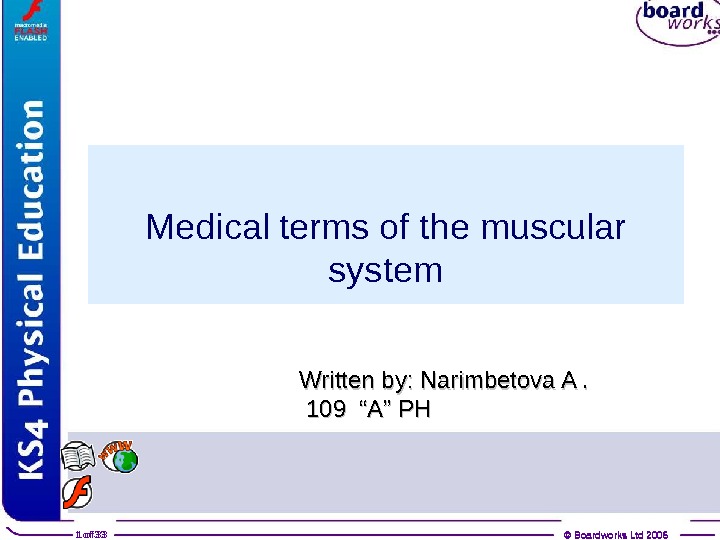
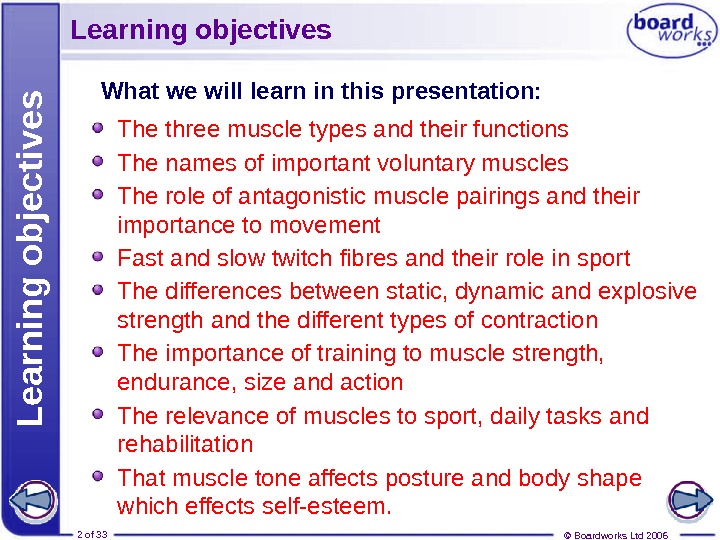
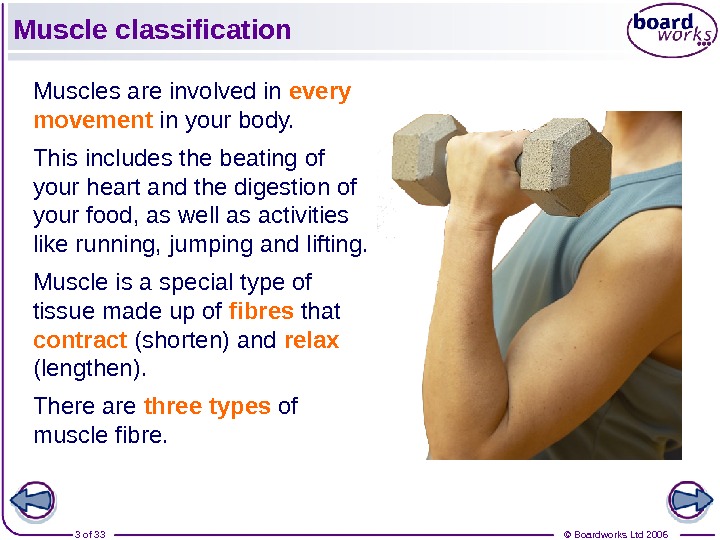
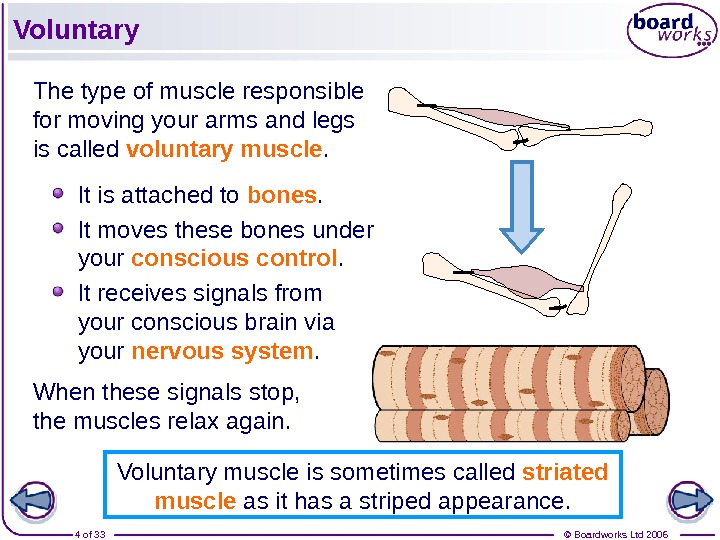

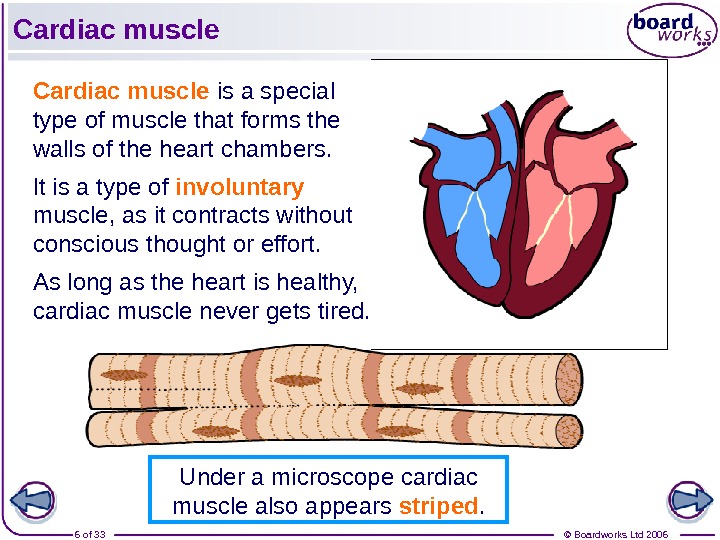
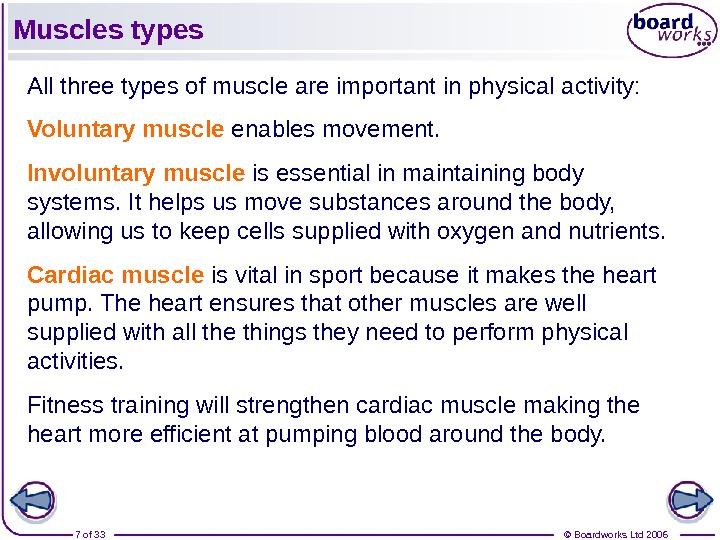
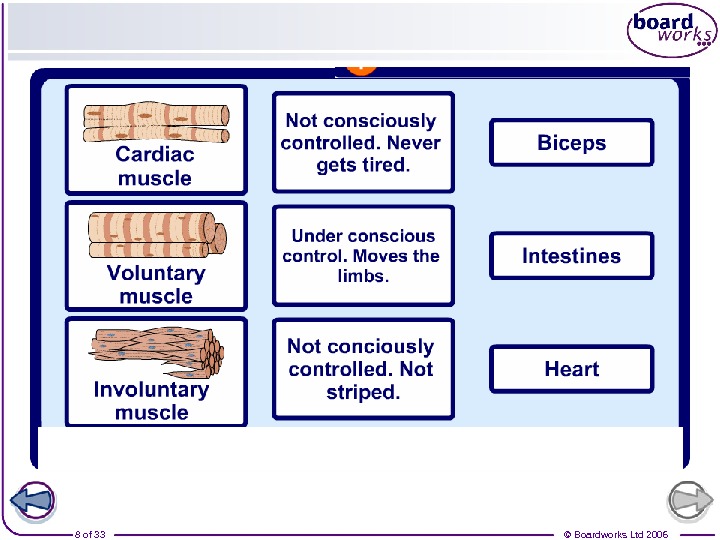
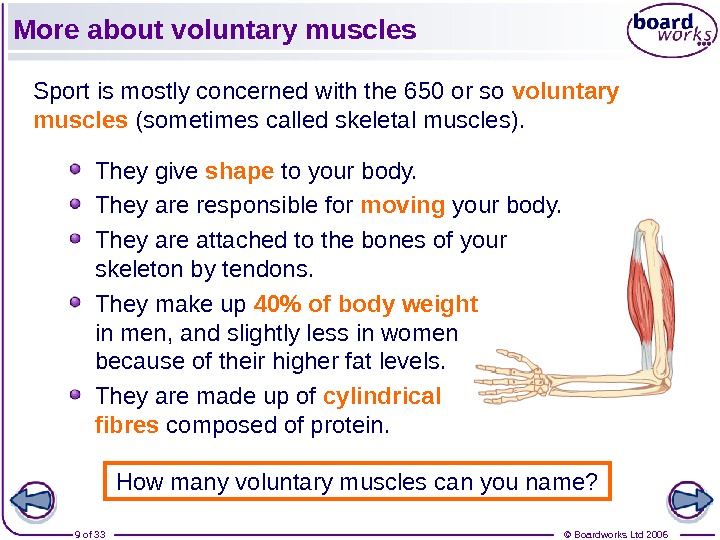
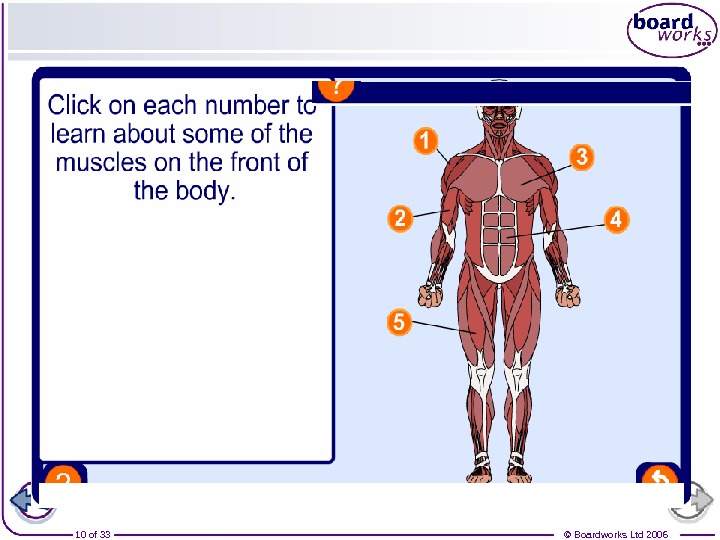
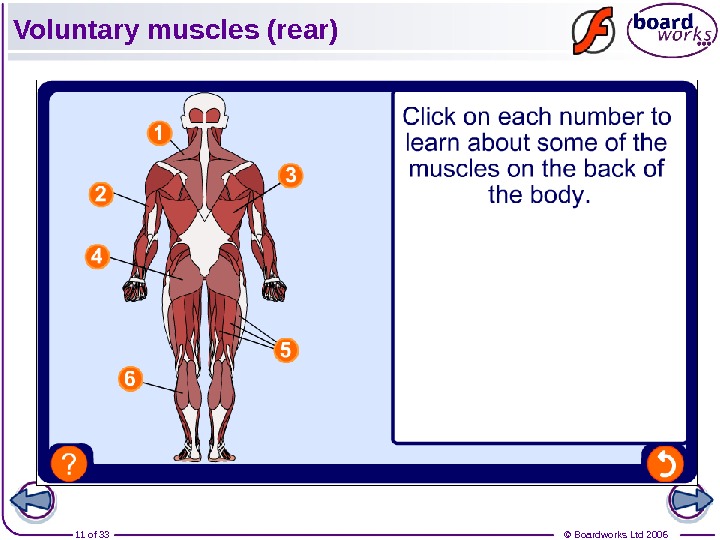
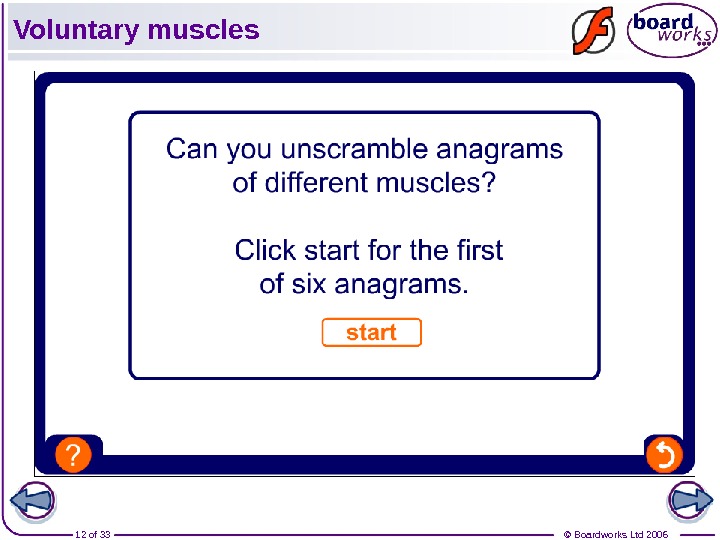
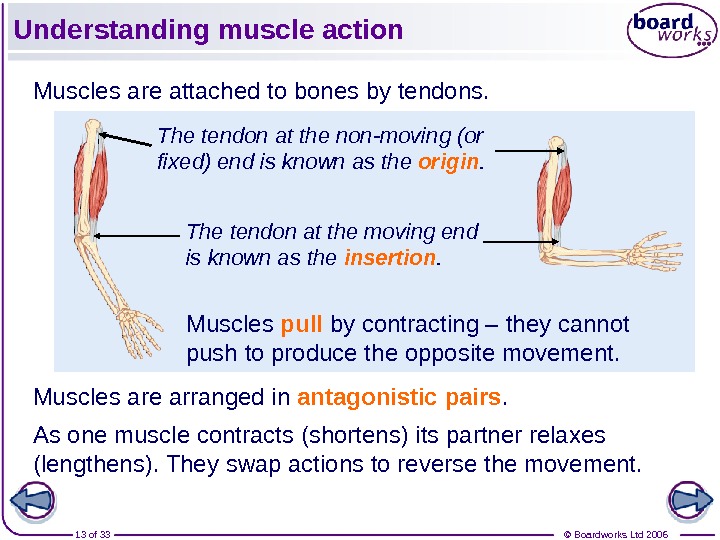

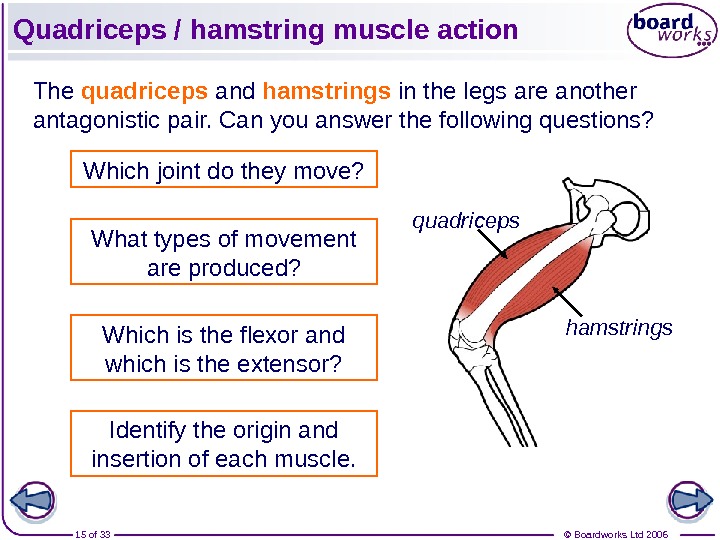


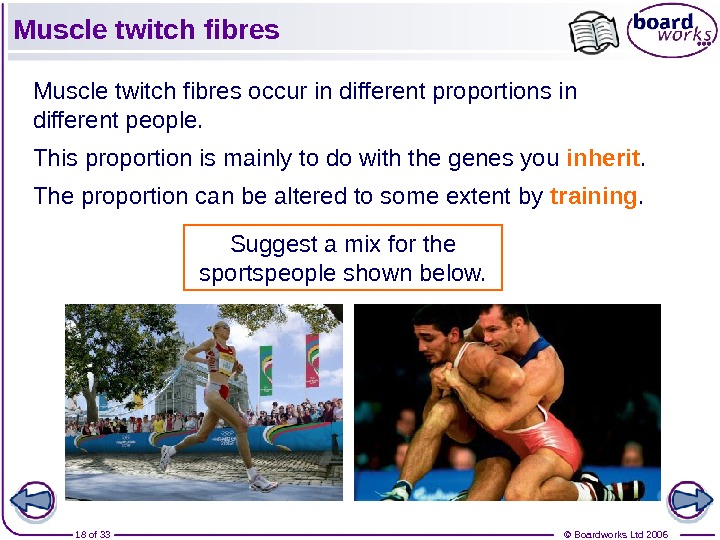

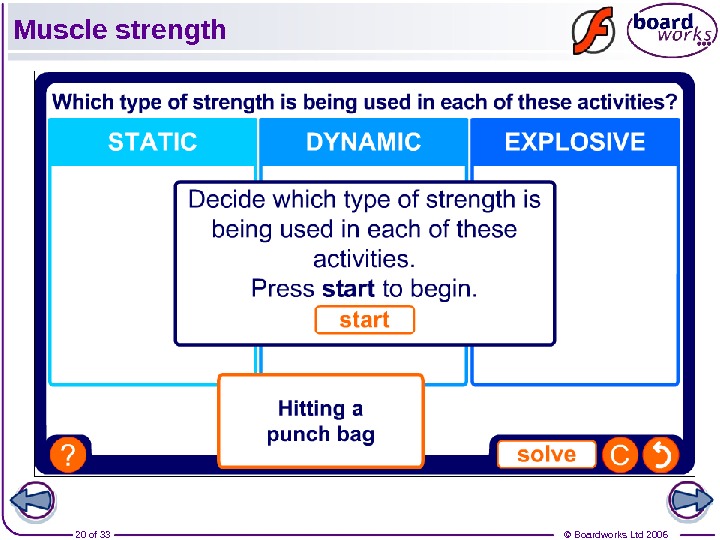
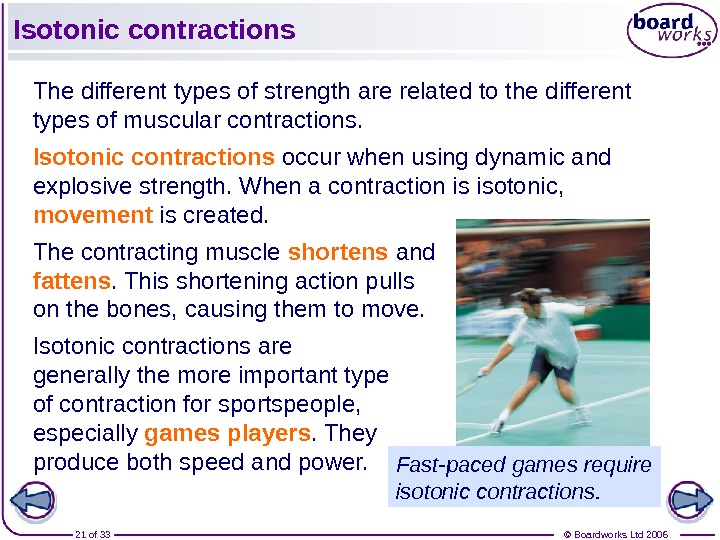
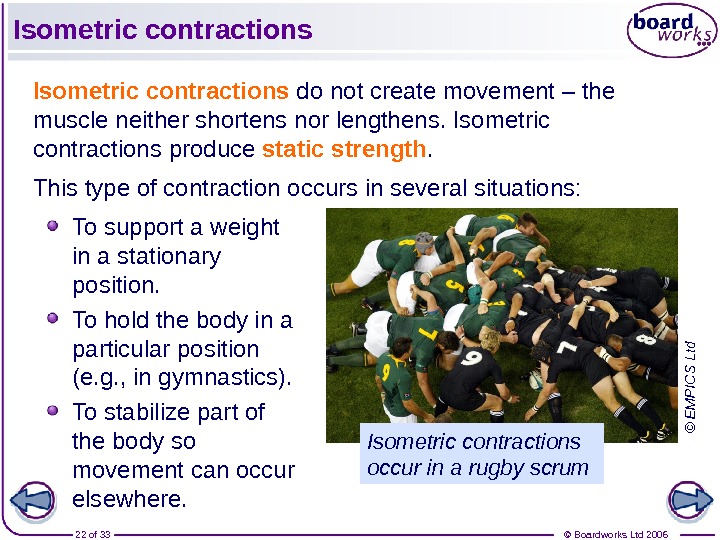
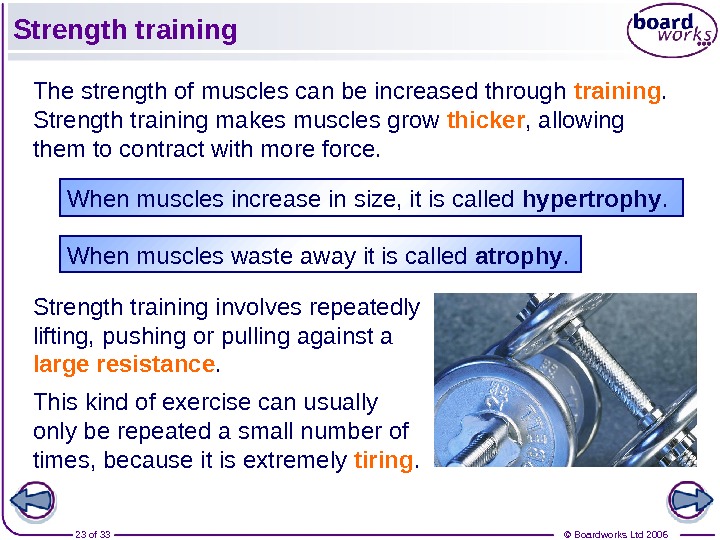
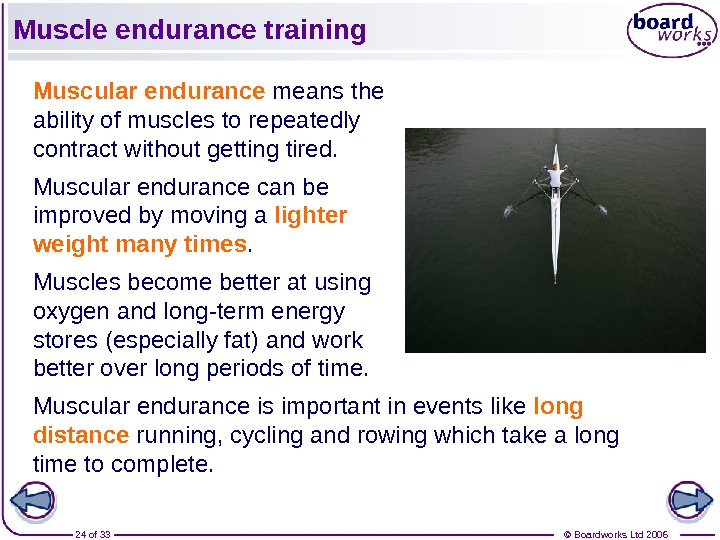


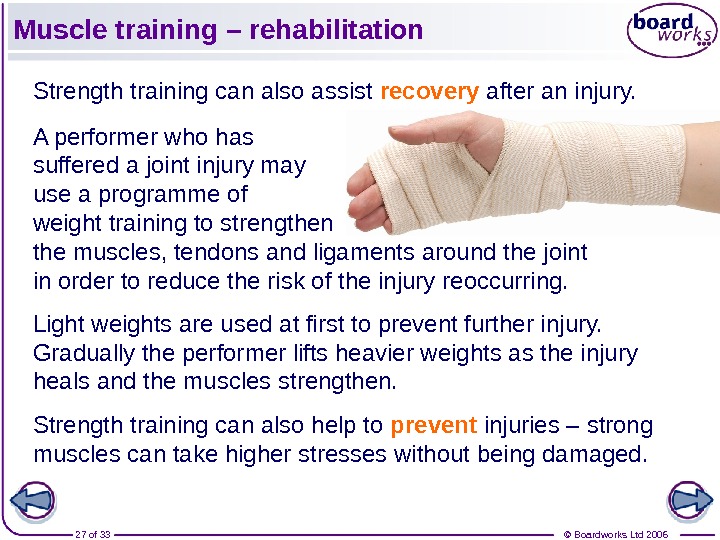
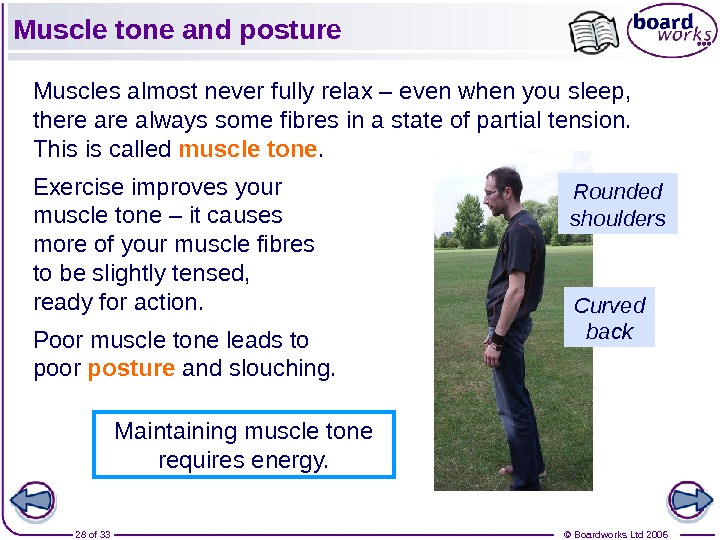
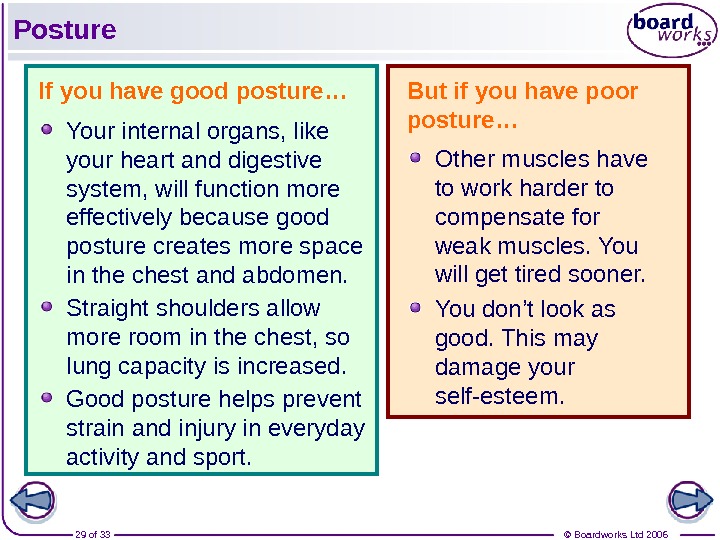
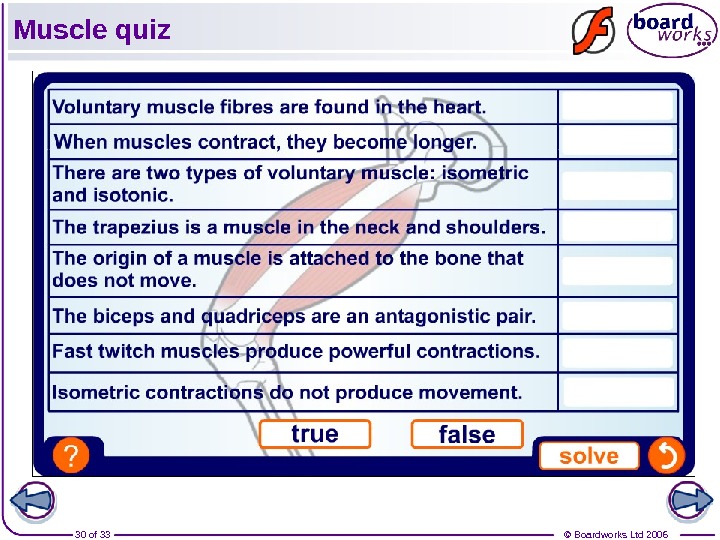
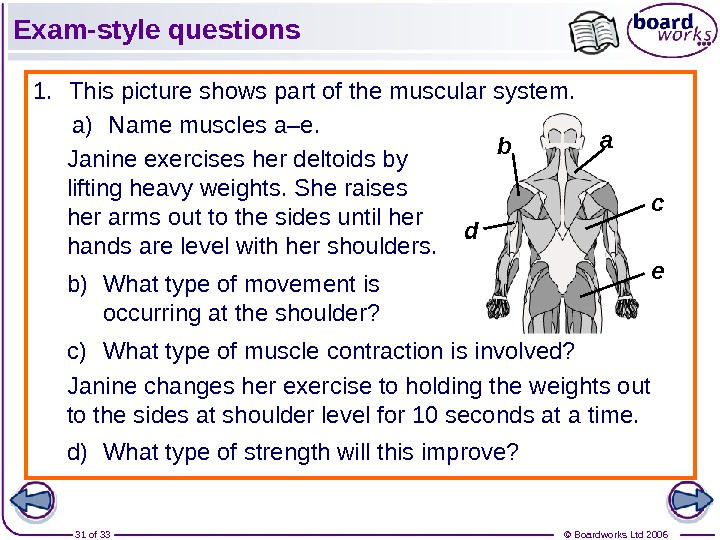
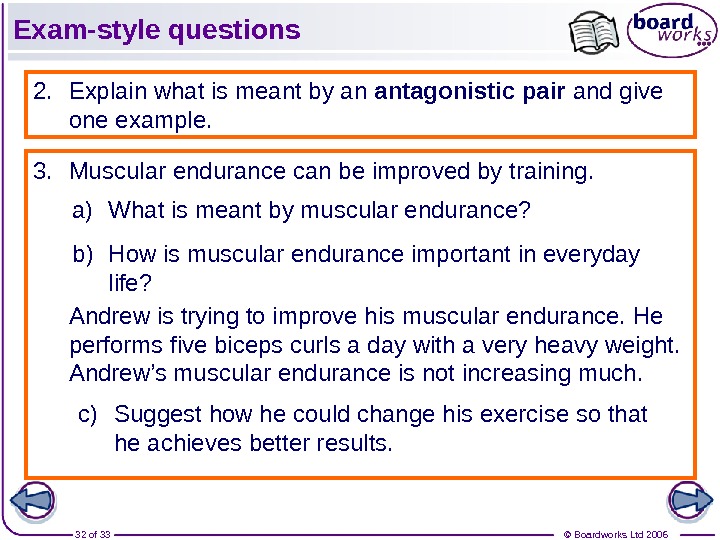
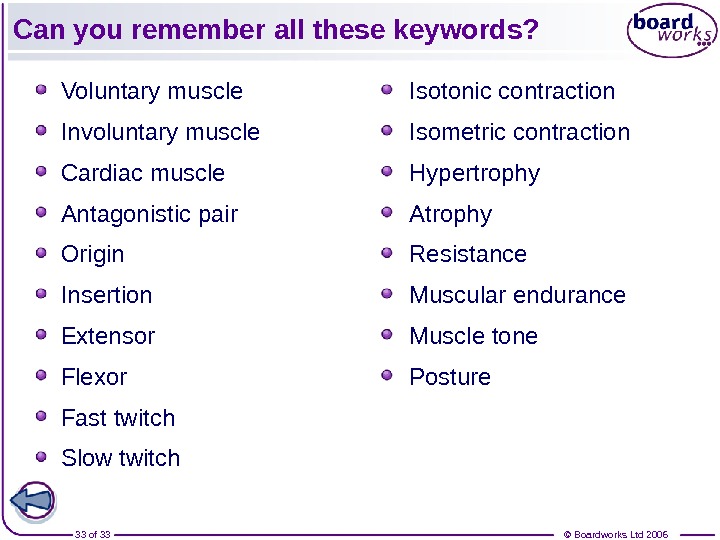
medical_terms_of_the_muscular_system.ppt
- Размер: 5.5 Mегабайта
- Количество слайдов: 33
Описание презентации © Boardworks Ltd 20061 of 33 Medical terms по слайдам
 © Boardworks Ltd 20061 of 33 Medical terms of the muscular system © Boardworks Ltd 20061 of 33 Written by: Narimbetova A. 109 ““ AA ”” PH PH
© Boardworks Ltd 20061 of 33 Medical terms of the muscular system © Boardworks Ltd 20061 of 33 Written by: Narimbetova A. 109 ““ AA ”” PH PH
 © Boardworks Ltd 20062 of 33 L e a r n in g o b je c t iv e s © Boardworks Ltd 20062 of 33 Learning objectives The three muscle types and their functions The names of important voluntary muscles The role of antagonistic muscle pairings and their importance to movement Fast and slow twitch fibres and their role in sport The differences between static, dynamic and explosive strength and the different types of contraction The importance of training to muscle strength, endurance, size and action The relevance of muscles to sport, daily tasks and rehabilitation That muscle tone affects posture and body shape which effects self-esteem. What we will learn in this presentation:
© Boardworks Ltd 20062 of 33 L e a r n in g o b je c t iv e s © Boardworks Ltd 20062 of 33 Learning objectives The three muscle types and their functions The names of important voluntary muscles The role of antagonistic muscle pairings and their importance to movement Fast and slow twitch fibres and their role in sport The differences between static, dynamic and explosive strength and the different types of contraction The importance of training to muscle strength, endurance, size and action The relevance of muscles to sport, daily tasks and rehabilitation That muscle tone affects posture and body shape which effects self-esteem. What we will learn in this presentation:
 © Boardworks Ltd 20063 of 33 Muscle classification Muscles are involved in every movement in your body. This includes the beating of your heart and the digestion of your food, as well as activities like running, jumping and lifting. Muscle is a special type of tissue made up of fibres that contract (shorten) and relax (lengthen). There are three types of muscle fibre.
© Boardworks Ltd 20063 of 33 Muscle classification Muscles are involved in every movement in your body. This includes the beating of your heart and the digestion of your food, as well as activities like running, jumping and lifting. Muscle is a special type of tissue made up of fibres that contract (shorten) and relax (lengthen). There are three types of muscle fibre.
 © Boardworks Ltd 20064 of 33 Voluntary The type of muscle responsible for moving your arms and legs is called voluntary muscle. It is attached to bones. It moves these bones under your conscious control. It receives signals from your conscious brain via your nervous system. When these signals stop, the muscles relax again. Voluntary muscle is sometimes called striated muscle as it has a striped appearance.
© Boardworks Ltd 20064 of 33 Voluntary The type of muscle responsible for moving your arms and legs is called voluntary muscle. It is attached to bones. It moves these bones under your conscious control. It receives signals from your conscious brain via your nervous system. When these signals stop, the muscles relax again. Voluntary muscle is sometimes called striated muscle as it has a striped appearance.
 © Boardworks Ltd 20065 of 33 Involuntary muscle is found in and around organs such as the intestines, and around blood vessels. It works without you consciously controlling it, or even being aware of it. Under a microscope it appears smooth, with no stripes.
© Boardworks Ltd 20065 of 33 Involuntary muscle is found in and around organs such as the intestines, and around blood vessels. It works without you consciously controlling it, or even being aware of it. Under a microscope it appears smooth, with no stripes.
 © Boardworks Ltd 20066 of 33 Cardiac muscle is a special type of muscle that forms the walls of the heart chambers. It is a type of involuntary muscle, as it contracts without conscious thought or effort. As long as the heart is healthy, cardiac muscle never gets tired. Under a microscope cardiac muscle also appears striped.
© Boardworks Ltd 20066 of 33 Cardiac muscle is a special type of muscle that forms the walls of the heart chambers. It is a type of involuntary muscle, as it contracts without conscious thought or effort. As long as the heart is healthy, cardiac muscle never gets tired. Under a microscope cardiac muscle also appears striped.
 © Boardworks Ltd 20067 of 33 Muscles types All three types of muscle are important in physical activity: Voluntary muscle enables movement. Involuntary muscle is essential in maintaining body systems. It helps us move substances around the body, allowing us to keep cells supplied with oxygen and nutrients. Cardiac muscle is vital in sport because it makes the heart pump. The heart ensures that other muscles are well supplied with all the things they need to perform physical activities. Fitness training will strengthen cardiac muscle making the heart more efficient at pumping blood around the body.
© Boardworks Ltd 20067 of 33 Muscles types All three types of muscle are important in physical activity: Voluntary muscle enables movement. Involuntary muscle is essential in maintaining body systems. It helps us move substances around the body, allowing us to keep cells supplied with oxygen and nutrients. Cardiac muscle is vital in sport because it makes the heart pump. The heart ensures that other muscles are well supplied with all the things they need to perform physical activities. Fitness training will strengthen cardiac muscle making the heart more efficient at pumping blood around the body.
 © Boardworks Ltd 20068 of
© Boardworks Ltd 20068 of
 © Boardworks Ltd 20069 of 33 More about voluntary muscles Sport is mostly concerned with the 650 or so voluntary muscles (sometimes called skeletal muscles). They give shape to your body. They are responsible for moving your body. They are attached to the bones of your skeleton by tendons. They make up 40% of body weight in men, and slightly less in women because of their higher fat levels. They are made up of cylindrical fibres composed of protein. How many voluntary muscles can you name?
© Boardworks Ltd 20069 of 33 More about voluntary muscles Sport is mostly concerned with the 650 or so voluntary muscles (sometimes called skeletal muscles). They give shape to your body. They are responsible for moving your body. They are attached to the bones of your skeleton by tendons. They make up 40% of body weight in men, and slightly less in women because of their higher fat levels. They are made up of cylindrical fibres composed of protein. How many voluntary muscles can you name?
 © Boardworks Ltd 200610 of
© Boardworks Ltd 200610 of
 © Boardworks Ltd 200611 of 33 Voluntary muscles (rear)
© Boardworks Ltd 200611 of 33 Voluntary muscles (rear)
 © Boardworks Ltd 200612 of 33 Voluntary muscles
© Boardworks Ltd 200612 of 33 Voluntary muscles
 © Boardworks Ltd 200613 of 33 Understanding muscle action Muscles are attached to bones by tendons. Muscles are arranged in antagonistic pairs. As one muscle contracts (shortens) its partner relaxes (lengthens). They swap actions to reverse the movement. The tendon at the moving end is known as the insertion. The tendon at the non-moving (or fixed) end is known as the origin. Muscles pull by contracting – they cannot push to produce the opposite movement.
© Boardworks Ltd 200613 of 33 Understanding muscle action Muscles are attached to bones by tendons. Muscles are arranged in antagonistic pairs. As one muscle contracts (shortens) its partner relaxes (lengthens). They swap actions to reverse the movement. The tendon at the moving end is known as the insertion. The tendon at the non-moving (or fixed) end is known as the origin. Muscles pull by contracting – they cannot push to produce the opposite movement.
 © Boardworks Ltd 200614 of 33 Upper arm muscles The biceps and triceps work together as an antagonistic pair to move the elbow joint. To flex the elbow, the biceps (the flexor) contracts and the triceps (the extensor) relaxes. To extend the elbow, the actions are reversed so that the triceps contracts and the biceps relaxes.
© Boardworks Ltd 200614 of 33 Upper arm muscles The biceps and triceps work together as an antagonistic pair to move the elbow joint. To flex the elbow, the biceps (the flexor) contracts and the triceps (the extensor) relaxes. To extend the elbow, the actions are reversed so that the triceps contracts and the biceps relaxes.
 © Boardworks Ltd 200615 of 33 Quadriceps / hamstring muscle action The quadriceps and hamstrings in the legs are another antagonistic pair. Can you answer the following questions? Which joint do they move? What types of movement are produced? Which is the flexor and which is the extensor? Identify the origin and insertion of each muscle. quadriceps hamstrings
© Boardworks Ltd 200615 of 33 Quadriceps / hamstring muscle action The quadriceps and hamstrings in the legs are another antagonistic pair. Can you answer the following questions? Which joint do they move? What types of movement are produced? Which is the flexor and which is the extensor? Identify the origin and insertion of each muscle. quadriceps hamstrings
 © Boardworks Ltd 200616 of 33 Voluntary muscles
© Boardworks Ltd 200616 of 33 Voluntary muscles
 © Boardworks Ltd 200617 of 33 Muscle twitch fibres Muscles are made up of cells or fibres. It is these fibres that contract. The number of fibres that contract, and their thickness , determines the amount of force that is applied. There are two basic types of voluntary muscle fibre: Fast twitch fibres are paler. They contract quickly and powerfully, but tire easily. Slow twitch fibres are deep red. They contract slowly, but can work for long periods.
© Boardworks Ltd 200617 of 33 Muscle twitch fibres Muscles are made up of cells or fibres. It is these fibres that contract. The number of fibres that contract, and their thickness , determines the amount of force that is applied. There are two basic types of voluntary muscle fibre: Fast twitch fibres are paler. They contract quickly and powerfully, but tire easily. Slow twitch fibres are deep red. They contract slowly, but can work for long periods.
 © Boardworks Ltd 200618 of 33 Muscle twitch fibres occur in different proportions in different people. This proportion is mainly to do with the genes you inherit. The proportion can be altered to some extent by training. Suggest a mix for the sportspeople shown below.
© Boardworks Ltd 200618 of 33 Muscle twitch fibres occur in different proportions in different people. This proportion is mainly to do with the genes you inherit. The proportion can be altered to some extent by training. Suggest a mix for the sportspeople shown below.
 © Boardworks Ltd 200619 of 33 Muscle strength Strength means the maximum force that muscles can exert when they contract. There are three different types of strength: Static strength The amount of force that muscles can apply to a stationary object. Dynamic strength The amount of force that muscles can apply to move a heavy object. Explosive strength The amount of force that muscles can exert in one fast movement. © EM PIC S Ltd
© Boardworks Ltd 200619 of 33 Muscle strength Strength means the maximum force that muscles can exert when they contract. There are three different types of strength: Static strength The amount of force that muscles can apply to a stationary object. Dynamic strength The amount of force that muscles can apply to move a heavy object. Explosive strength The amount of force that muscles can exert in one fast movement. © EM PIC S Ltd
 © Boardworks Ltd 200620 of 33 Muscle strength
© Boardworks Ltd 200620 of 33 Muscle strength
 © Boardworks Ltd 200621 of 33 Isotonic contractions The different types of strength are related to the different types of muscular contractions. Isotonic contractions occur when using dynamic and explosive strength. When a contraction is isotonic, movement is created. The contracting muscle shortens and fattens. This shortening action pulls on the bones, causing them to move. Isotonic contractions are generally the more important type of contraction for sportspeople, especially games players. They produce both speed and power. Fast-paced games require isotonic contractions.
© Boardworks Ltd 200621 of 33 Isotonic contractions The different types of strength are related to the different types of muscular contractions. Isotonic contractions occur when using dynamic and explosive strength. When a contraction is isotonic, movement is created. The contracting muscle shortens and fattens. This shortening action pulls on the bones, causing them to move. Isotonic contractions are generally the more important type of contraction for sportspeople, especially games players. They produce both speed and power. Fast-paced games require isotonic contractions.
 © Boardworks Ltd 200622 of 33 Isometric contractions do not create movement – the muscle neither shortens nor lengthens. Isometric contractions produce static strength. This type of contraction occurs in several situations: To support a weight in a stationary position. To hold the body in a particular position (e. g. , in gymnastics). To stabilize part of the body so movement can occur elsewhere. Isometric contractions occur in a rugby scrum© EM PIC S Ltd
© Boardworks Ltd 200622 of 33 Isometric contractions do not create movement – the muscle neither shortens nor lengthens. Isometric contractions produce static strength. This type of contraction occurs in several situations: To support a weight in a stationary position. To hold the body in a particular position (e. g. , in gymnastics). To stabilize part of the body so movement can occur elsewhere. Isometric contractions occur in a rugby scrum© EM PIC S Ltd
 © Boardworks Ltd 200623 of 33 Strength training The strength of muscles can be increased through training. Strength training makes muscles grow thicker , allowing them to contract with more force. Strength training involves repeatedly lifting, pushing or pulling against a large resistance. This kind of exercise can usually only be repeated a small number of times, because it is extremely tiring. When muscles increase in size, it is called hypertrophy. When muscles waste away it is called atrophy.
© Boardworks Ltd 200623 of 33 Strength training The strength of muscles can be increased through training. Strength training makes muscles grow thicker , allowing them to contract with more force. Strength training involves repeatedly lifting, pushing or pulling against a large resistance. This kind of exercise can usually only be repeated a small number of times, because it is extremely tiring. When muscles increase in size, it is called hypertrophy. When muscles waste away it is called atrophy.
 © Boardworks Ltd 200624 of 33 Muscle endurance training Muscular endurance means the ability of muscles to repeatedly contract without getting tired. Muscular endurance can be improved by moving a lighter weight many times. Muscles become better at using oxygen and long-term energy stores (especially fat) and work better over long periods of time. Muscular endurance is important in events like long distance running, cycling and rowing which take a long time to complete.
© Boardworks Ltd 200624 of 33 Muscle endurance training Muscular endurance means the ability of muscles to repeatedly contract without getting tired. Muscular endurance can be improved by moving a lighter weight many times. Muscles become better at using oxygen and long-term energy stores (especially fat) and work better over long periods of time. Muscular endurance is important in events like long distance running, cycling and rowing which take a long time to complete.
 © Boardworks Ltd 200625 of 33 Muscle training
© Boardworks Ltd 200625 of 33 Muscle training
 © Boardworks Ltd 200626 of 33 Muscle training – everyday tasks Improving muscle strength and endurance through training can make everyday tasks easier. Many everyday tasks like gardening, moving furniture and ironing require physical exertion. If you are stronger and have better muscular endurance, you will find these tasks less tiring. Muscular endurance is generally more important in everyday life – most people rarely have to lift something that is very heavy. People who do very physical jobs , for example, farmers and builders, may need higher levels of strength.
© Boardworks Ltd 200626 of 33 Muscle training – everyday tasks Improving muscle strength and endurance through training can make everyday tasks easier. Many everyday tasks like gardening, moving furniture and ironing require physical exertion. If you are stronger and have better muscular endurance, you will find these tasks less tiring. Muscular endurance is generally more important in everyday life – most people rarely have to lift something that is very heavy. People who do very physical jobs , for example, farmers and builders, may need higher levels of strength.
 © Boardworks Ltd 200627 of 33 Muscle training – rehabilitation Strength training can also assist recovery after an injury. Light weights are used at first to prevent further injury. Gradually the performer lifts heavier weights as the injury heals and the muscles strengthen. Strength training can also help to prevent injuries – strong muscles can take higher stresses without being damaged. A performer who has suffered a joint injury may use a programme of weight training to strengthen the muscles, tendons and ligaments around the joint in order to reduce the risk of the injury reoccurring.
© Boardworks Ltd 200627 of 33 Muscle training – rehabilitation Strength training can also assist recovery after an injury. Light weights are used at first to prevent further injury. Gradually the performer lifts heavier weights as the injury heals and the muscles strengthen. Strength training can also help to prevent injuries – strong muscles can take higher stresses without being damaged. A performer who has suffered a joint injury may use a programme of weight training to strengthen the muscles, tendons and ligaments around the joint in order to reduce the risk of the injury reoccurring.
 © Boardworks Ltd 200628 of 33 Muscle tone and posture Muscles almost never fully relax – even when you sleep, there always some fibres in a state of partial tension. This is called muscle tone. Exercise improves your muscle tone – it causes more of your muscle fibres to be slightly tensed, ready for action. Poor muscle tone leads to poor posture and slouching. Maintaining muscle tone requires energy. Rounded shoulders Curved back
© Boardworks Ltd 200628 of 33 Muscle tone and posture Muscles almost never fully relax – even when you sleep, there always some fibres in a state of partial tension. This is called muscle tone. Exercise improves your muscle tone – it causes more of your muscle fibres to be slightly tensed, ready for action. Poor muscle tone leads to poor posture and slouching. Maintaining muscle tone requires energy. Rounded shoulders Curved back
 © Boardworks Ltd 200629 of 33 Posture If you have good posture… But if you have poor posture… Your internal organs, like your heart and digestive system, will function more effectively because good posture creates more space in the chest and abdomen. Straight shoulders allow more room in the chest, so lung capacity is increased. Good posture helps prevent strain and injury in everyday activity and sport. Other muscles have to work harder to compensate for weak muscles. You will get tired sooner. You don’t look as good. This may damage your self-esteem.
© Boardworks Ltd 200629 of 33 Posture If you have good posture… But if you have poor posture… Your internal organs, like your heart and digestive system, will function more effectively because good posture creates more space in the chest and abdomen. Straight shoulders allow more room in the chest, so lung capacity is increased. Good posture helps prevent strain and injury in everyday activity and sport. Other muscles have to work harder to compensate for weak muscles. You will get tired sooner. You don’t look as good. This may damage your self-esteem.
 © Boardworks Ltd 200630 of 33 Muscle quiz
© Boardworks Ltd 200630 of 33 Muscle quiz
 © Boardworks Ltd 200631 of 33 Exam-style questions 1. This picture shows part of the muscular system. a) Name muscles a–e. a b c d e. Janine exercises her deltoids by lifting heavy weights. She raises her arms out to the sides until her hands are level with her shoulders. b) What type of movement is occurring at the shoulder? c) What type of muscle contraction is involved? Janine changes her exercise to holding the weights out to the sides at shoulder level for 10 seconds at a time. d) What type of strength will this improve?
© Boardworks Ltd 200631 of 33 Exam-style questions 1. This picture shows part of the muscular system. a) Name muscles a–e. a b c d e. Janine exercises her deltoids by lifting heavy weights. She raises her arms out to the sides until her hands are level with her shoulders. b) What type of movement is occurring at the shoulder? c) What type of muscle contraction is involved? Janine changes her exercise to holding the weights out to the sides at shoulder level for 10 seconds at a time. d) What type of strength will this improve?
 © Boardworks Ltd 200632 of 33 Exam-style questions 2. Explain what is meant by an antagonistic pair and give one example. 3. Muscular endurance can be improved by training. Andrew is trying to improve his muscular endurance. He performs five biceps curls a day with a very heavy weight. Andrew’s muscular endurance is not increasing much. a) What is meant by muscular endurance? b) How is muscular endurance important in everyday life? c) Suggest how he could change his exercise so that he achieves better results.
© Boardworks Ltd 200632 of 33 Exam-style questions 2. Explain what is meant by an antagonistic pair and give one example. 3. Muscular endurance can be improved by training. Andrew is trying to improve his muscular endurance. He performs five biceps curls a day with a very heavy weight. Andrew’s muscular endurance is not increasing much. a) What is meant by muscular endurance? b) How is muscular endurance important in everyday life? c) Suggest how he could change his exercise so that he achieves better results.
 © Boardworks Ltd 200633 of 33 Can you remember all these keywords? Voluntary muscle Involuntary muscle Cardiac muscle Antagonistic pair Origin Insertion Extensor Flexor Fast twitch Slow twitch Isotonic contraction Isometric contraction Hypertrophy Atrophy Resistance Muscular endurance Muscle tone Posture
© Boardworks Ltd 200633 of 33 Can you remember all these keywords? Voluntary muscle Involuntary muscle Cardiac muscle Antagonistic pair Origin Insertion Extensor Flexor Fast twitch Slow twitch Isotonic contraction Isometric contraction Hypertrophy Atrophy Resistance Muscular endurance Muscle tone Posture

